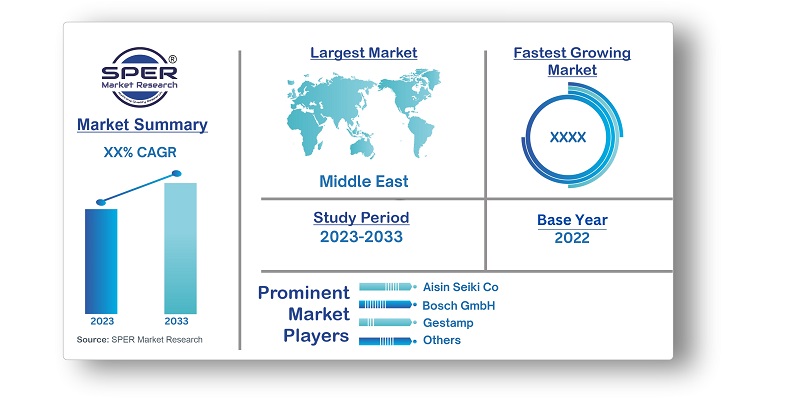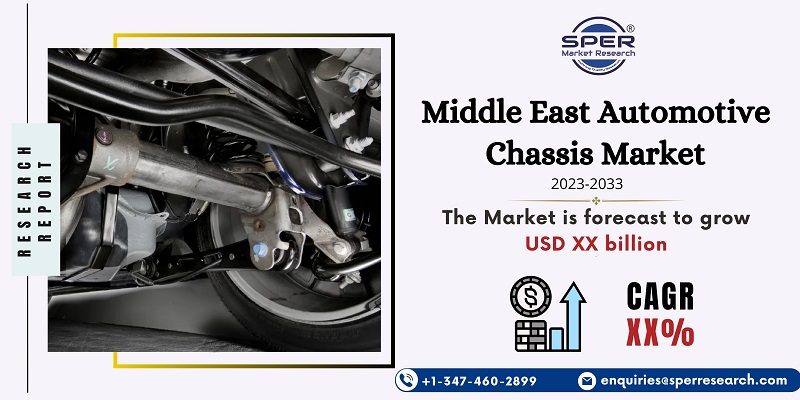
Middle East Automotive Chassis Market Growth, Trends, Size, Revenue, Share and Future Outlook
Middle East Automotive Chassis Market Size– By Chassis Type, By Type, By Electric Vehicle- Regional Outlook, Competitive Strategies and Segment Forecast to 2033
| Published: Feb-2024 | Report ID: AMIN2450 | Pages: 1 - 153 | Formats*: |
| Category : Automotive & Transportation | |||
- May 2022: The American electric car maker Lucid Group announced that it was opening its first foreign location in Saudi Arabia. At first, the factory will cater to the local market and have the capacity to produce 155,000 automobiles annually.
- August 2023: To establish the biggest spare parts center in the Middle East and Africa, Neweast General Trading and Jebel Ali Free Zone (Jafza) entered into a leasing agreement. The corporation plans to transform a 165,000 square meter area within the free zone into a sizable hub for spare part distribution with an investment of about USD 136.2 million.


| Report Metric | Details |
| Market size available for years | 2019-2033 |
| Base year considered | 2022 |
| Forecast period | 2023-2033 |
| Segments covered | By Chassis Type, By Material, By Electric Vehicle |
| Regions covered | Saudi Arabia, UAE, Qatar, Kuwait, Oman, Bahrain, and Turkey |
| Companies Covered | Aisin Seiki Co., Ltd., Bosch GmbH, Gestamp, BENTELER International AG, Tower International, Tenneco Inc., ZF Friedrichshafen AG and various others. |
- Automotive Chassis Manufacturers
- Automobile Original Equipment Manufacturers (OEMs)
- Automotive Suppliers and Distributors
- Automotive Repair and Maintenance Shops
- Fleet Owners and Managers
- Government and Regulatory Bodies
- Investors and Financial Institutions
- Research and Development Centers
- Consumers and Vehicle Owners
| By Chassis Type: |
|
| By Material: |
|
| By Electric Vehicle: |
|
- Middle East Automotive Chassis Market Size (FY’2023-FY’2033)
- Overview of Middle East Automotive Chassis Market
- Segmentation of Middle East Automotive Chassis Market By Chassis Type (Backbone, Ladder, Modular, Monocoque)
- Segmentation of Middle East Automotive Chassis Market By Material (Aluminum Alloy, Carbon Fiber Composite, Steel)
- Segmentation of Middle East Automotive Chassis Market By Electric Vehicle (BEV, HEV, PHEV)
- Statistical Snap of Middle East Automotive Chassis Market
- Expansion Analysis of Middle East Automotive Chassis Market
- Problems and Obstacles in Middle East Automotive Chassis Market
- Competitive Landscape in the Middle East Automotive Chassis Market
- Impact of COVID-19 and Demonetization on Middle East Automotive Chassis Market
- Details on Current Investment in Middle East Automotive Chassis Market
- Competitive Analysis of Middle East Automotive Chassis Market
- Prominent Players in the Middle East Automotive Chassis Market
- SWOT Analysis of Middle East Automotive Chassis Market
1.1. Scope of the report1.2. Market segment analysis
2.1. Research data source2.1.1. Secondary Data2.1.2. Primary Data2.1.3. SPER’s internal database2.1.4. Premium insight from KOL’s2.2. Market size estimation2.2.1. Top-down and Bottom-up approach
2.3. Data triangulation
4.1. Driver, Restraint, Opportunity and Challenges analysis4.1.1. Drivers4.1.2. Restraints4.1.3. Opportunities4.1.4. Challenges4.2. COVID-19 Impact of the Middle East Automotive Chassis Market
5.1. SWOT Analysis5.1.1. Strengths5.1.2. Weaknesses5.1.3. Opportunities5.1.4. Threats5.2. PESTEL Analysis5.2.1. Political Landscape5.2.2. Economic Landscape5.2.3. Social Landscape5.2.4. Technological Landscape5.2.5. Environmental Landscape5.2.6. Legal Landscape5.3. PORTER’s Five Forces5.3.1. Bargaining power of suppliers5.3.2. Bargaining power of buyers5.3.3. Threat of Substitute5.3.4. Threat of new entrant5.3.5. Competitive rivalry5.4. Heat Map Analysis
6.1. Middle East Automotive Chassis Market Manufacturing Base Distribution, Sales Area, Type, Chassis Type6.2. Mergers & Acquisitions, Partnerships, Type Launch, and Collaboration in Middle East Automotive Chassis Market
7.1. Middle East Automotive Chassis Market Value Share and Forecast, By Chassis Type, 2023-20337.2. Backbone7.3. Ladder7.4. Modular7.5. Monocoque
8.1. Middle East Automotive Chassis Market Value Share and Forecast, By Material, 2023-20338.2. Aluminum Alloy8.3. Carbon Fiber Composite8.4. Steel
9.1. Middle East Automotive Chassis Market Value Share and Forecast, By Type, 2023-20339.2. BEV9.3. HEV9.4. PHEV
10.1. Middle East Automotive Chassis Market Size and Market Share
11.1. Middle East Automotive Chassis Market Size and Market Share By Chassis Type (2019-2026)11.2. Middle East Automotive Chassis Market Size and Market Share By Chassis Type (2027-2033)
12.1. Middle East Automotive Chassis Market Size and Market Share By Material (2019-2026)12.2. Middle East Automotive Chassis Market Size and Market Share By Material (2027-2033)
13.1. Middle East Automotive Chassis Market Size and Market Share By Electric Vehicle (2019-2026)13.2. Middle East Automotive Chassis Market Size and Market Share By Electric Vehicle (2027-2033)
14.1. Middle East Automotive Chassis Market Size and Market Share By Region (2019-2026)14.2. Middle East Automotive Chassis Market Size and Market Share By Region (2027-2033)14.2.1. Bahrain14.2.2. Kuwait14.2.3. Oman14.2.4. Qatar14.2.5. Saudi Arabia14.2.6. Turkey
14.2.7. UAE
15.1. Aisin Seiki Co., Ltd.15.1.1. Company details15.1.2. Financial outlook15.1.3. Type summary15.1.4. Recent developments15.2. Bosch GmbH15.2.1. Company details15.2.2. Financial outlook15.2.3. Type summary15.2.4. Recent developments15.3. BENTELER International AG15.3.1. Company details15.3.2. Financial outlook15.3.3. Type summary15.3.4. Recent developments15.4. Gestamp15.4.1. Company details15.4.2. Financial outlook15.4.3. Type summary15.4.4. Recent developments15.5. Tenneco Inc.15.5.1. Company details15.5.2. Financial outlook15.5.3. Type summary15.5.4. Recent developments15.6. Tower International15.6.1. Company details15.6.2. Financial outlook15.6.3. Type summary15.6.4. Recent developments15.7. ZF Friedrichshafen AG15.7.1. Company details15.7.2. Financial outlook15.7.3. Type summary15.7.4. Recent developments15.8. Teva Pharmaceuticals15.8.1. Company details15.8.2. Financial outlook15.8.3. Type summary15.8.4. Recent developments15.9. Others
SPER Market Research’s methodology uses great emphasis on primary research to ensure that the market intelligence insights are up to date, reliable and accurate. Primary interviews are done with players involved in each phase of a supply chain to analyze the market forecasting. The secondary research method is used to help you fully understand how the future markets and the spending patterns look likes.
The report is based on in-depth qualitative and quantitative analysis of the Product Market. The quantitative analysis involves the application of various projection and sampling techniques. The qualitative analysis involves primary interviews, surveys, and vendor briefings. The data gathered as a result of these processes are validated through experts opinion. Our research methodology entails an ideal mixture of primary and secondary initiatives.



Frequently Asked Questions About This Report
PLACE AN ORDER
Year End Discount
Sample Report
Pre-Purchase Inquiry
NEED CUSTOMIZATION?
Request CustomizationCALL OR EMAIL US
100% Secure Payment






Related Reports
Our Global Clients
Our data-driven insights have influenced the strategy of 200+ reputed companies across the globe.




















